#Brick Victorian farm house
Text

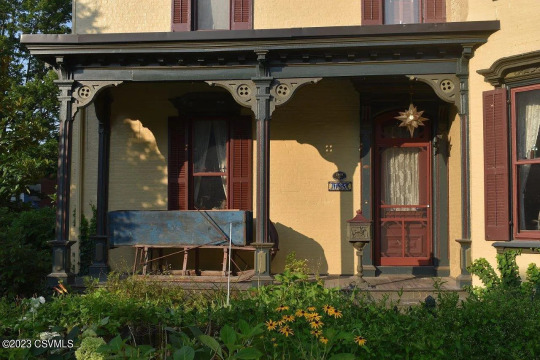
This 1855 Victorian in Lewisburg, Pennsylvania is for sale just in time for Halloween b/c it's the consummate witches house. 6bds, 4ba, $795K.
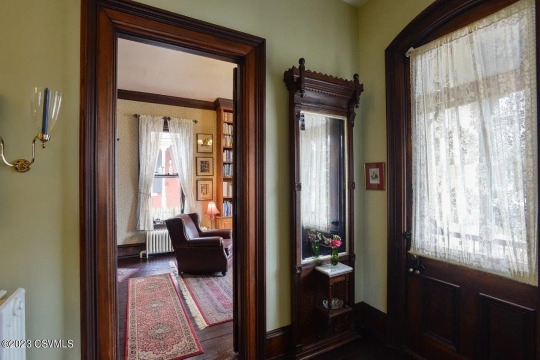

There's the typical center hall with an original curving staircase.

A cozy sitting room. This home is basically original and just needs a little sprucing up.
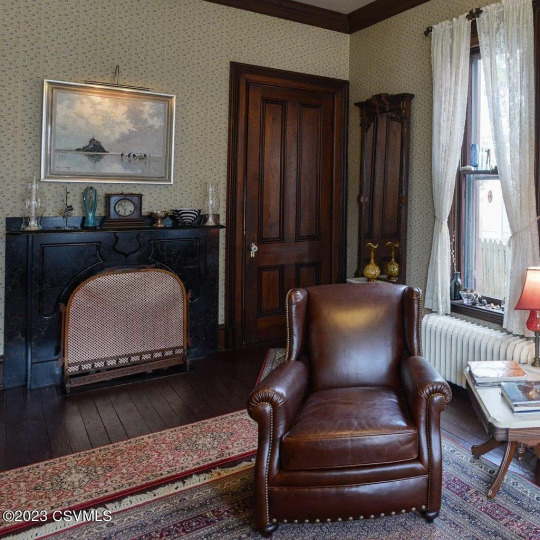
Look at the fireplace. It's original.

This sitting room is also nice and has a fancier fireplace. I wonder what's under the black paint.
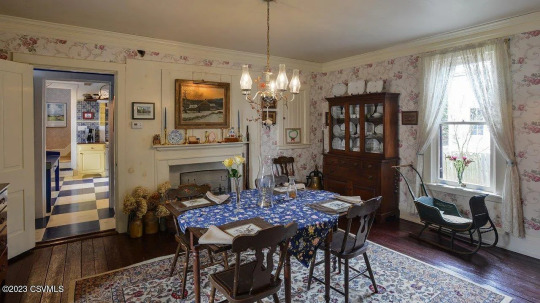
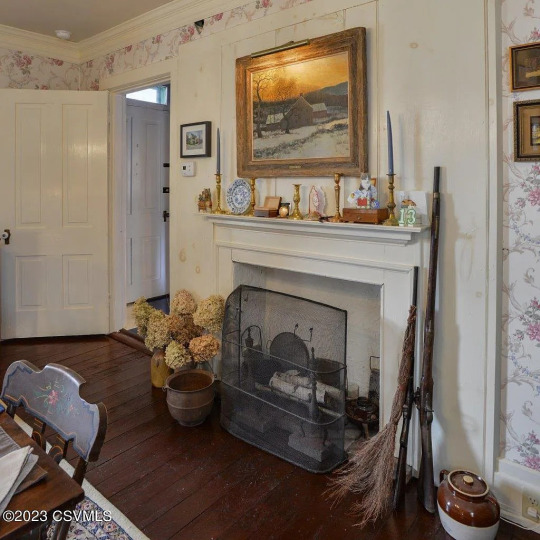
Cute dining room has cupboards around the fireplace.



The kitchen is too cute. It's so vintage and I love that. Look at the antique stove in the original cooking fireplace. It has coffered ceilings and the cool blue & white checkered floor with matching backsplashes and contrasting yellow cabinetry. A bonus is the marble farm sink.

Right off the kitchen is this bright blue powder room with an antique corner sink. The bright blue and white match the floor.

The stairs are so graceful.
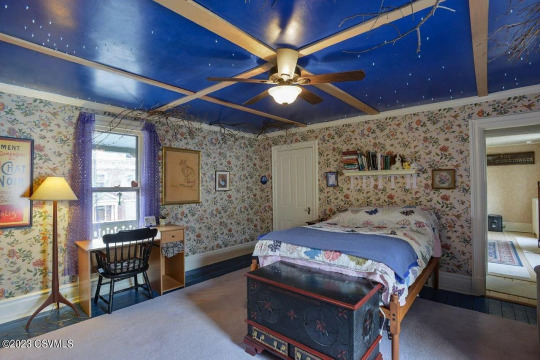

Upstairs are the bedrooms and this one has a cute starry ceiling.
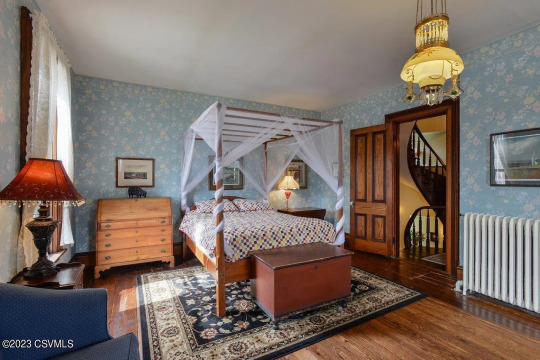
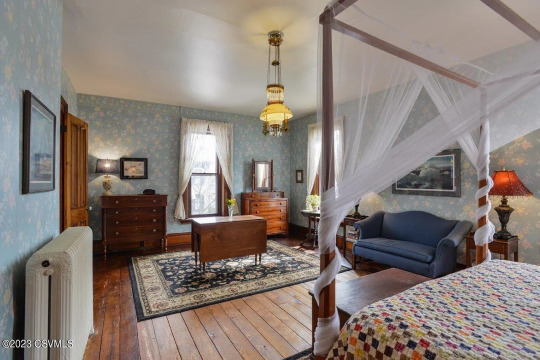
This larger bedroom appears to be the primary and it has enough room for a full sitting area.
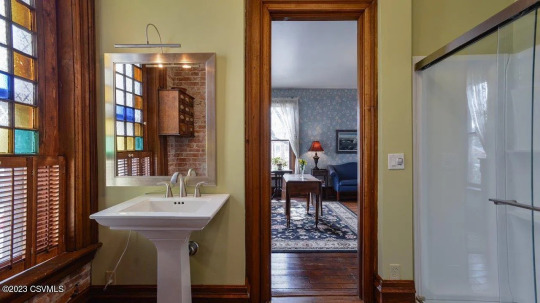
The primary has it's own en-suite.

This bedroom also has an en-suite and lovely exposed brick walls. I love the pedestal sinks in each bath. And, they also have beautiful stained glass windows.

Isn't this stunning?

I can't get enough of this swooping staircase.
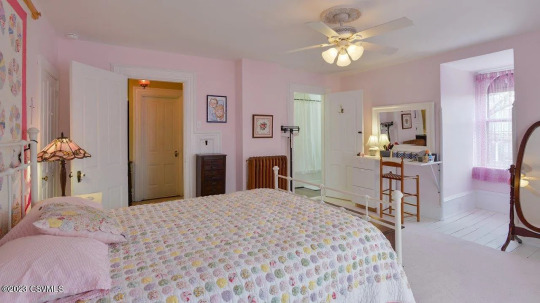
Very pretty room up here.

And, look at the cute little en-suite.

It's light and bright up here. Beautiful archway.
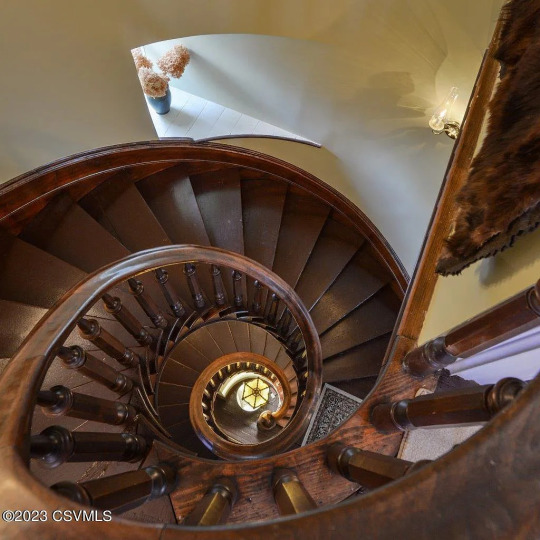
Look at these stairs! They are glorious.
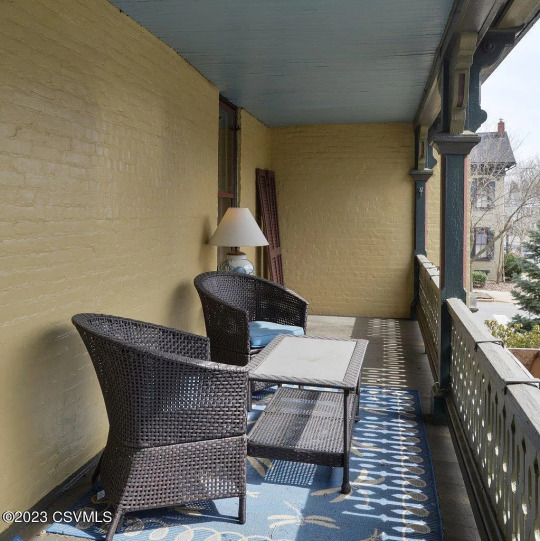
This is wonderful, an upper floor porch.
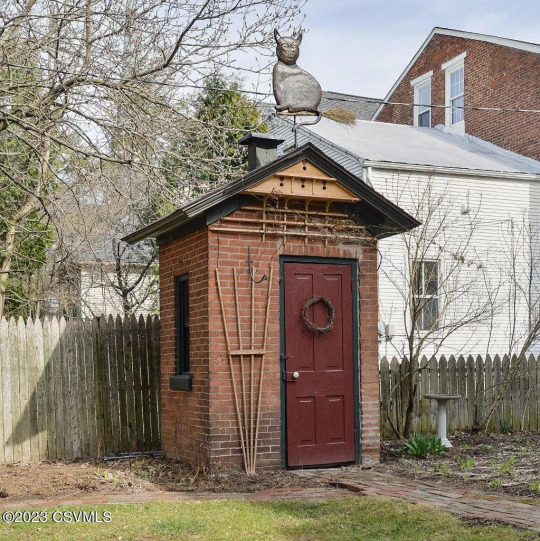
I wonder if this little shed was once an outhouse.
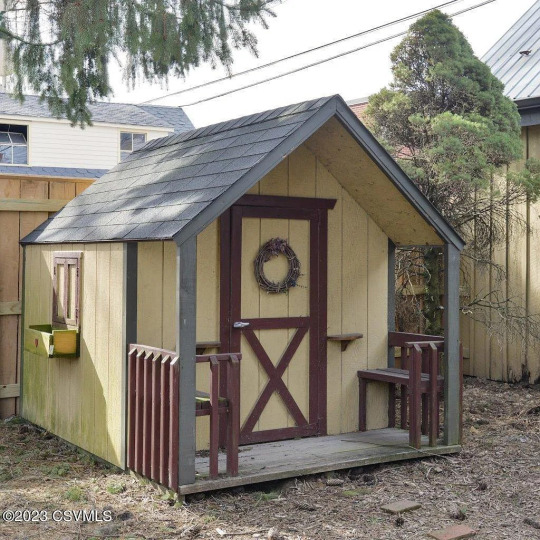
This one has a tiny porch and 2 benches. How adorable is that?

Patio & screened picnic area. Love the roof.
270 notes
·
View notes
Text


Witch!Reader x Bat/Vampire!Eddie Munson
Series Masterlist
The Grimoire
The Timeline
Warnings: canon typical violence, horror genre typical violence/some infrequent gore, swearing, animal death, no beta, death in childbirth (mentioned, not described), abusive parents, suicide, spiders/bugs, grief/mourning; light smut; warnings updated each chapter.
Synopsis: No witch has stepped foot in Hawkins since 1845, but when Vecna opens the ground and poisons the town, a voice begins to call to you. Have you been brought back to this cursed place to heal the townspeople’s wounds, to save a hexed bat that always finds its way to you, or to redefine your history with a reunion 150 years in the making?
Chapter Summary: You are wide awake. 2340 words.

1986
Every day Eddie watched the jar. He watched how the moon water moved, alive and with a viscosity different from regular water. He watched the apple slices dry and the sprigs of lavender go stiff. He thought if he watched closely enough, he’d see the magic working, but he never caught a glimmer of craft.
When it was time, you let him plant the enchanted seed in the new coven neighbourhood. Your home would grow furthest out, close to the shade of the woods. A spell later, you were traveling back to Forest Hills to begin packing the trailer up.
It had been months since you’d moved in, therefore you had accumulated a lot of items.
“Do you need all of these?” Eddie asked, holding up one of five shoeboxes, all packed with feathers you had found. “And is this a normal amount of feathers to find? What is wrong with the birds in Hawkins?”
“Yes and no and a lot. I told you that if you are gonna help, you can’t question every single thing you pick up,”
“I’m doing no such thing,” he rebutted.
“Eddie, you told me to cull my jar collection,”
“I stand by it. There are too many. You can collect more,”
“I use them! Frequently! And I don’t just keep any jar. All the ones I have are, like, uniquely shaped or extra sturdy!” you whined. “Asking a witch to not collect jars is just…” You shook your head, not able to find the words to express the atrocity.
Eddie smiled at you softly. “Perhaps I am not the best helper,” he conceded. “Perhaps my time would be better spent doing something else,”
“Something else like use your vampire speed to clean the bathroom, or something else like turn into a bat and sleep?”
An hour later, Eddie was asleep in one of the boxes containing clothes, and you were wrapping more empty jars in bubble wrap.
…
A monument to witchcraft and love. That’s what Eddie thought when he saw the house. It had the glorious drama of Ev’s Victorian home and the softness of the other witches’ cottages. Expansive stained glass windows. Detailed architraves, the wood so dark it appeared black. Red brick. A single-story structure, but the dome of a conservatory was visible over the roof. It extended back into the woods, settling into the landscape as if it had always been there.
Eddie thought back to all the places he had lived in. The house his father’s rage felt the brunt of as much as he did. The farm he came into adulthood on. The colony caves. The cold and lonely hotel rooms. The trees above Forest Hills. He’d never had a home, apart from your arms, but there it was. Real and in front of him.
The sun was setting over the valley as Eddie stood before the house. You’d seen it early that day, doing your final checks before okaying the move. It was your magic the house grew from, so naturally you were less awestruck by it. The floorplan and aesthetic had been born in your mind. Still, it was a beautiful thing.
“Think it will do?” you asked Eddie, coming to stand beside him.
He couldn’t tear his eyes away from it. “It’s…” How many different words were there for ‘home,’ he wondered. What language could fully communicate the depth of emotion?
“Enchanted seeds create homes, not houses,” you told him as you walked towards the front door. “Come and see.”
Eddie followed, almost expecting something to happen as he crossed the front door threshold. Once inside, Eddie clenched his jaw. It was more perfect than he could have anticipated.
The furniture was plush and comfortable, an eclectic mix of antique pieces and modern amenities. Bookshelves stood tall and waiting, ready for the library to arrive. Potted ivy trailed up and around curtain railings and along the walls.
“You never got to see my place in the Catskills. A lot of the furniture comes from there. The rest comes from the seed… It’s the kind of magic that makes me wish we could study it, you know? I want to know the science of it. How does it work?”
“It seems to me that part of the power of magic is in the unknowing,” Eddie replied, as wise as any of the Witches Who Came Before.
“It does appear to be the case,” you agreed.
For a while, you let Eddie wander aimlessly through the house.
He marvelled at the bath, huge and round, like a pond and definitely big enough for two. A huge wardrobe door that opened into a secret library. The conservatory full of thriving plants, flowers, herbs, and other living things Eddie did not have a word for. Every window a different shape but never square. Strange detailing like cat shaped doorknobs and pink quartz basins.
Eventually, Eddie sat on the end of the huge bed, its four posts grand and its linen crisp. He looked over at you and held out his hands.
“Come.”
You walked to him, taking his hands, and standing between his legs. Eddie looked up at you with those sparkling brown eyes, the adoration radiating from him.
“It’s an irrational idea, this fear I have that I’m dreaming. That I am still cursed, haunting this town until the end of time. But a vampire cannot dream. The cursed cannot dream. But still…”
Gently, you let go of Eddie’s hands and leaned into him, snaking your fingers into his hair as he pressed himself into your body, wrapping his arms around your waist.
“You are wide awake. Alive… kind of… But definitely here. With me. In our home. Soon-to-be, with our friends. Our family. And just in time for Halloween.”
He purred a happy sound, nodding into you. “A witch’s favourite holiday?” he hazarded a guess.
“Hmm, not all of us. Most of the witches I’ve known tended to find more obscure holidays to worship at the altar of. New Years is a big one, too. Alas, I am but a cliché All Hallows witch,”
“With much respect, I see that,” Eddie said. You laughed, shrugged. He looked up at you again. “You did fall in love with a vampire, after all.”
…
Far away from the rest of the world, you and Eddie spent almost a week settling into the new house. Grimoires were catalogued into one of the three library rooms. Dandelion puffs were jarred and shelved. Every trinket found its home.
Eddie tested the rainbow light that flooded the rooms, discovering that in the magic there was safety. Sunlight that filtered through the windows did not burn him. He could be free and at ease.
You explained to Eddie the importance of representing the elements within the home. Earth in the plants, wooden carpentry, and the grounding crystals. Fire in the candles, ever-burning incense, and roaring fireplaces that only ever emitted the exact level of heat you wanted. (“In summer, the flames burn cold,” you told Eddie and watched his smile grow.) Water in the mirrors, seashells, and small fountains found in the glasshouse room. Lastly, air in the wind chimes, feathers, and windows that could remain open without upsetting the temperature inside.
During the day, you began work on your garden, creating flower beds in the shape of pentagrams and sewing seeds. Borage for the butterflies and bees, primrose – I can’t live without you; angelica in case you need to break any future hexes; and yarrow, amaryllis, and polypodies.
One evening, just before sunset, you found Eddie rummaging through the apothecary pantry. As you entered the room, his manic smile told you he’d had an idea.
“What’s the story, morning glory?” you asked him, perching on a stool.
Eddie sunk to his knees and shrugged. “The fires are out… The Shire is no longer burning,”
“The Shire being… Hawkins?”
“Yes. And us. We’ve sailed to the Undying Lands,”
“You’re really making Tolkien your whole personality, huh?” you joked.
Eddie smiled up at you. “Until the next book… But what I’m saying is, now that we do not have a battle to prepare for. No conflict upon the horizon. What do we do with all of eternity?”
“Oh… My plan was to eat a lot of Meg’s cinnamon rolls… Try to get Steve Harrington to stop haunting Mel… Maybe work on a spell to make myself teeny tiny so I can ride around on you when you’re a bat…”
“Wait, seriously?”
You gave him a sly smile. “Maybe,”
“Well, I would love that… But, I was thinking a little more introspectively. Back to things we have thought about before. Like, why I am the way that I am… What that means…” He ran a finger along the leaves of the mimosa pudica plant beside him. The leaves felt his touch, curled inwards on themselves. It was one of Eddie’s favourites, the way it reacted to the world around it.
“Any new insights?” you asked softy.
“No… But… If I believe in you and in your magic and the way you make sense of the world… then I… I have to do something,”
“Do something?”
“We get back what we give, right?”
“Yeah,” you agreed. “It’s not always obvious or direct. Or timely. Or even equally fair… But, yeah… There is definitely something like the concept of karma at play. And even if there isn’t, living as if there is can only be a good thing,”
“Then I must show more grace… and gratitude… Even if I am a monster, maybe especially because I am… I can give goodness too.”
Without thinking, you slid off the stool and joined Eddie on the floor. “You already do. You don’t owe the world anything.”
Eddie smiled, first a small soft thing, almost sad, but then it twisted into something else. Ear-to-ear and full of teeth. “I owe it more than one life,”
“But if we count all the lives you have saved. Both by killing what plagued this town, and by preventing deaths at the hands of bad people-”
“Morality cannot be simple addition and subtraction. There is no math that can quantify goodness or righteousness. You know that,” Eddie cut in. He watched your face, saw the pensiveness blossom across it. “Don’t worry, my little witch, my plan is not as life-or-death as this all makes it seem… I just want to do something good for your friends,”
“Your friends,” you corrected quickly. “They’ll be your friends too. Your family. You’re part of this coven.”
Eddie reached out to cup your face in his hands. “Your coven is yours. But I will take the friendship. I have years of loneliness to make up for,”
“Then what-”
He cut you off again, this time with a kiss. You brought your hands up to his shoulders, draping your arms around his neck. Eddie pulled you into his lap and you curled into him like the leaves of the mimosa.
His mouth kissed and sucked at your neck between sentence fragments. “I’m-” kiss “going-” kiss “to plant-” lick “them-” kiss “flowers.” His punctuation a kiss that wanted to be a bite.
You were hardly listening to his words. His words and ideas and introspective musings could all wait.
Eddie laid you down on the floor, the smell of the oak still new. You arched your back and pulled him down by his collar.
“Bed,” you mumbled into his mouth.
“Why build a house if we’re not gonna use it,” he answered.
One hand splayed next to your head to keep him up, the other tickling its way under the hem of your skirt and up your thigh.
“Besides,” Eddie said. “Doesn’t feel like you can wait.” He was sliding your underwear off, throwing them across the room. He rested a hand on you, sliding an index finger through your slickness.
“I can’t,” you agreed, breathy and impatient. “Now. I want you now.”
Eddie didn’t have to be asked twice. With his pants still hanging from an ankle, he was fast to set up and slow on approach. You felt the tip of him follow the path made by his hand, gathering wetness, and shooting electricity through your body.
You melted into jelly beneath him, bliss written all over your face. Eddie loved you like this, pliable and prone to tears of ecstasy.
He held himself back, keeping his pace slow and steady. His vampire muscles screamed to go faster, to rail you into next week, but he liked pulling you apart. Liked how you unconsciously uttered strings of words like ‘full’ and ‘please’ and ‘can’t.’ Liked when you clawed at him to come closer, bit down on his shoulder.
“I love you,” he told you, mouth on your ear, tongue licking. “So. Fucking. Much.”
There was a seemingly endless amount of ways Eddie had learned could make you cum. Talking to you was a favourite for you both.
“You’re so perfect, so perfect… You feel so perfect… You’re so warm and soft and I… I want to eat you whole…”
Your response was in the pooling tears and the nodding and the slack jaw. The begging, “Please. Please.”
“I love you. I love you. I love you.” It was all it took. Your orgasm exploded moments before his. Eddie’s thrusting getting harder and faster for the few seconds he took to follow you. He had to grind his teeth together to stop himself from ripping into your neck.
You kept your eyes closed, not aware of your surroundings. When you felt Eddie’s arms slide beneath you, you smiled and hummed. He carried you to your new bed, cleaning your skin with a warm washcloth before curling himself in behind you.
With the last of your day’s energy, you tangled your fingers through his, falling asleep happily.
As Eddie listened to your breathing find its mellow night rhythm, he saw a vision of you in his mind. Hands full of flowers and foliage. A coven of audience. Glorious and beaming.
End Note: I made a small Pinterest board with inspo for their house - click here to view.
I hope you are all as well as any of us can be at a time like this. I hope this story continues to provide comfort, escapism, and fuel for daydreams. xo Rhi
Fic Taglist: @paranoidmunson @idkidknemore @paprikaquinn @stardustworlds @loz-brooke @wyverntatty @vintagehellfire @dark-academia-slut @scarletwitchwhore @becks1002 @mrsdollardog @heyndrix @luceneraium @rosaline-black @devilinthepalemoonlite @goldencherriess @iamwhisperingstars @wiltedwonderland @blueywrites @breezybeesposts @jadehowlettthewolf @spikesvamp79 @foreveranexpatsposts @tortoiseshellspells @wingedpeachjudgegiant @stardustmunson @live-love-be-unique @fangirling-4-ever @reanimated-alice @b-irock @gh0stlybunnie @myown-worstenemy-2003 @woozzz @cyberxlust @hiscrimsonangel @buckysbarne @m00nlight101 @word-wytch @spicysix @briasnow-blog @goth-cowgirl-03 @moviefreak1205 @pastel-pillows
All Eddie Taglist: @solomons-finest-rum @ruinedbythehobbit @sweetpeapod @thorfemmes @corrodedhawkins @grungegrrrl @lilzabob @averagemisfit03 @ches-86 @ilovecupcakesandtea @onehotgreasymechanic @hazydespair @mel-the-fangirl @eddies-hid3out @siren-lungs @aheadfullofsteverogers @hiscrimsonangel @dashingdeb16 @cultish-corner
#Mine#Burning Yarrow#Eddie Munson#Vampire!Eddie Munson#Bat!Eddie Munson#Eddie Munson x Reader#Eddie Munson x You#Eddie Munson/Reader#Eddie Munson/You
76 notes
·
View notes
Text

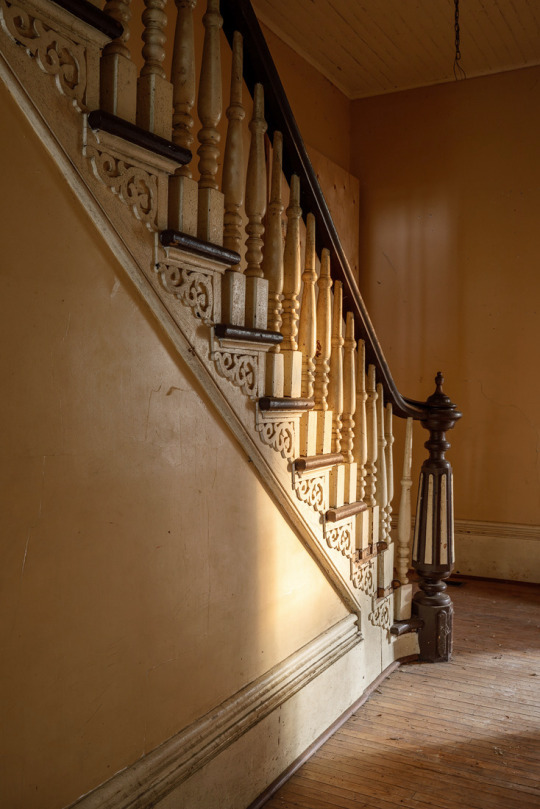



The Victorian
As always, the full video tour can be found below!
Finally, let's close out this incredible location by taking a look at a few photos from the ground floor, along with the incredible staircase!
Sitting on 112 acres, the original farm property dates back to the mid to late 19th century. While the Victorian house itself and original barn were built in the early 1900s.
The home had two towers, one on the front of the building and one on the west side of the house. During a time of neglect, the west side tower had began to pull away from the house and had to be removed. The owners at the time also removed all of the brick and added siding as a replacement.
In the early 1930s, the original barn burnt to the ground in a devastating fire. The owner at the time was later charged with arson. He thought that if the barn burned down, he could use the proceeds from the insurance claim to pay off the mortgage. A replacement barn was built years later and still sits on the property to this day.
Several years ago the property was sold to a development company and the buildings have sat abandoned and decaying ever since.
Unfortunately, the house is not protected under the heritage act and it will almost certainly be demolished in the future when the land is redeveloped.
#abandoned#urbex#urban exploring#urban exploration#bandos#abandoned buildings#abandoned places#forgotten#abandoned houses#forgotten buildings#abandoned homes#forgotten places#Victorian houses#Victorian farmhouses#Victorian#abandoned farmhouses
24 notes
·
View notes
Note
I want to hear about you growing up in haunted house.
How did you know it was haunted?
Was it scary or where you so young you just didn't know to be scared?
Why do you think it was haunted?
Oh lord. Story time.
So the house was victorian in era and in the middle of nowhere. I was.. I think like no more then 10-11 years old? When I say middle of nowhere I mean it. We didn't get buses. We had a FARM and like 3-4 other houses then just miles of country.
This was some of the views [HOUSE WAS EMPTY DURING THESE IMAGES/HAS NO SIGNS OF WHERE ITS LOCATED, I THINK ACODRING TO THE HOUSE SELLING SITE THERE IS STILL NO ONE THERE ATM]


So, the house was always cold anyway because it's made of thick bricks and no real instalation or at least when we lived there. It had 2 liveable floors and then an atic.
The atic scared my mother so she never went there and there was a wasps nest up in the top and my step dad was deadly alergric to bees/wasps.
Him and my uncle went up like ONCE ever to check it out and make sure everything was okay, later the wasps were sorted out but anyway.
The windows were brand new, double glazing and heavy because England needs double glazing for the weather. So the windows, brand new, heavy, plastic and thick. Not orginal creaky ass windows. Now, no one goes into the attack but sometimes late at night when we drove back home the window would be open.
My step dad would run up and close it but wouldn't hang around there, so I dont class that as 'going into the atttic' it was just to fix the window, I remember mood feeding on them both about anxiety for it.
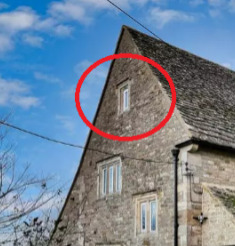
Some backstory about my family. My mother and step father were NO MESS people. Don't believe in ghosts, luck, aliens, God. Nothing. And I didn't know about ghosts.
Everynight I heard scarping in the attic and was told it was rats [Yes we did have rats but now as a rat owner, no way was that rats] and the floors creaking downstairs at night.
Old house, old houses move and shift, thats fine.
I had my own room [it was a 3 bedroom] and I remember everynight laying there in bed as a young kid and I always thought it was my step dad peering around the corner to watch me, make sure I'd settled down to bed. He was always just a black shape but my room was dark save for a little nightlight and a hall light on so I didn't think it was creepy. Just thought my step dad didn't trust me to go to bed. This happened the entire like.. 4 years we lived there?
[LATER: when talking to my mother as an adult about it I was like 'Why did STEPDAD do that?' mother looks at me confused and tells me 'he never did that']
Now the real kicker for me is something I overheard YEARS after we moved. I'm what 15-16 when I overhead my step dad and uncle talking. They were talking about the house.
Why did we leave? it was so cheap for something that big.
My step dad with no humour in his voice. 'We had to go, she got too close' 'Everynight she was there, it started at the bottom but every night she got closer and closer and closer, she was right outside the window, we had to leave'
From a mad who wasn't phased by anything that was hard to listen to.
the circle shows where she started and made her way up to the kitchen window. I don't know what she looked like, he only ever said 'all white'

15 notes
·
View notes
Text

A Georgian house, a Victorian red brick house and a plaster farm house on an Afterlife estate.
1 note
·
View note
Text



Nettle Farm Exterior
someone teach me how the fuck to install reshade
Built using @pierisim's Domaine du Clos and Maison Maulière build sets, and @felixandresims's Colonial build set.
Lengthy rambling under the cut about styling choices, architectural history, and inspiration.
For my Decades Challenge I wanted to capture the appearance of a mid-late 19thC British farmhouse such as those I've seen my whole life in the countryside, only grander as I'm a slut for some Neoclassicism. See some examples/inspirations:



Late Victorian brickwork in the South of England is usually red-orange in colour and can be quite intricate, with a focus on symmetry and balance. Contrast stones can be used as lintels, frames, and corner pieces, but for a cheaper build only brick will be used (no need to pay a stonemason, then!) Exposed wood, such as the door, window frames, decorate eaves etc, would be sealed and painted to preserve it against damp weather and boring insects. White is the cheapest choice, but if you wanted to show off you could go for something a little more colourful such as blue, green, or red. Modern occupants like to go for these dusty duck egg blue type colours (see the door on example three), but such pigments weren't typical at the time of construction. Roofing material will depend on the area in which the house is built and the budget of the purchaser, but I wanted to reflect the popularity of slate (also I just really like a good grey-brown roof). One thing that I love on roofs is a proper weather vane, but I had to settle for a decorative roof thingamabob instead. Nothing screams "brick farmhouse" to me like a weather vane on the roof!
For what little of a garden there is I took inspiration from the world of Henford-on-Bagley where this was built, and followed more of a cottage garden look than Victorian - organic, non-structured, and floral. Also I just couldn't not add Wisteria to the house, because I absolutely love the stuff. The scent is just stunning.
The interior of the build isn't yet at a point where I'm happy to share it. Partially because I ran out of simoleans for the family, and partially because the routing in the Sims is so restrictive. I grew up in tiny old cottages where the couch sat in front of the book case, and we dealt with it just fine! >:( Still, I will try and polish it and then post a couple of pictures with more ramblings about the interior decorating fashions of the late Victorian/early Edwardian period.
#the sims 4#ts4#ts4 exterior#ts4 build#the sims 4 build#ts4 historical#sims 4 historical#ts4 decades challenge#putting my incredibly expensive history of art degree to good use by rambling about late victorian architecture and decorative arts#dr lucetta johnson are you proud of me?
1 note
·
View note
Link
0 notes
Text
Philadelphia Shopping Guide - Where to Shop, Eat, and Have Fun on a Weekend

Unlike the other major cities, Philadelphia is not known for its fashion-forward shops. However, if you know where to look, you can find a number of excellent shops that will keep you busy on a Saturday or Sunday. You will also find plenty of restaurants and cafes to keep you entertained.
Philadelphia is also known for its cheesesteaks. If you are in the mood for a snack, try one of the many food markets in the city. The Philadelphia Italian Market is an excellent source of traditional Italian fare. In addition to the usual suspects, you can find a variety of foods, including pastas, cured meats, fresh vegetables and fruits, and specialty cheeses. The best part is that you can take advantage of Pennsylvania's arcane liquor laws, making it easier for restaurants to go BYOB.
You will also find several of the city's best museums, including the Museum of the American Revolution, which offers a curated tour of American history. The museum is located near Rittenhouse Square. You can also check out the Mutter Museum, which is a great resource for learning about morbid anatomy. The Philadelphia Mummers Museum is also interesting, as it teaches you about working-class culture. You might also want to check out the National Constitution Center, which is a super-lively museum.
The Philadelphia Mills is an enclosed mall located in the Northeast part of the city. It is not located in Center City, but it is only fifteen miles away. It's a great place to pick up a few items, and you can also take advantage of free WiFi. It is also home to the Wanamaker Organ, a massive pipe organ that's been installed in Macy's.
The Philadelphia Museum of Art is also a great place to visit. You'll see a variety of works of art, including some of the largest pieces in the world. You can also check out the Barnes Foundation, which features a well-curated selection of European and African art. In addition to the museum, you can also catch a live performance on the Wanamaker Organ.
The West End is an eclectic shopping area that's worth a visit. It's filled with excellent shops, including the Magic Gardens, an ongoing art project. You might also want to stop in to one of the many restaurants in the area, such as Little Nonna's and Tria. There are also several great wine bars to choose from. You'll also find several excellent shops in the Headhouse District.
The East Village is also worth a look. Its main street is reminiscent of the storybook Main Street. It's also the home of one of the city's best wine bars, Tria. It's also a great place to see the art deco buildings of Philadelphia, including the iconic Rittenhouse Hotel. You can also get a great drink at the Yardley Ice House, a local spot for creative flavors.
You'll also find a number of impressive landmarks, such as the Liberty Bell and Independence Hall. The Liberty Bell is one of the oldest structures in Philadelphia, and it is also the site of the Declaration of Independence.
Located in Cherry Hill, Pennsylvania, it's no secret that Barclay Farm is a hotspot for the locals and visitors. A plethora of boutiques, diners, and ad hoc restaurants have been keeping the locals happy. A slew of upscale boutiques and hotels have also taken their share of business. The best part of all is that Barclay Farm is also the most family friendly neighborhood in the county.
Downtown Malvern is a great place to find great shops and restaurants. There is a lot of Victorian architecture. The town is also close to King of Prussia Mall.
Residential Epoxy Flooring
The best residential epoxy flooring options are also easy to clean. They're resistant to water, chemicals, and other corrosive substances. The epoxy coating can be applied to various surfaces, including wood, concrete, and brick pavers.
They're available in a variety of colors and finishes, including clear epoxy, wood grain, metallic, and patterned designs. You can also choose to add glitter or other embedded items into the resin coating.
Epoxy flooring is an excellent option for high traffic areas in a home. It's also very durable and easy to clean.

Residential epoxy flooring is also popular for patios. These outdoor areas of a house are used to soak up the sun and connect with family members. Patios bear the weight of heavy items, so it's important that they're durable.
Philadelphia Epoxy Flooring
1625 W Oregon Ave, Philadelphia, PA 19145
(215) 500-2612
https://epoxyflooringphiladelphia.com/
0 notes
Text

The United States is home to many people from around the globe. This is true not only in terms of ethnicity but also in terms of cultural and socioeconomic status. American architecture is a blend of styles and designs from around the globe.
There are so many home design options that you can choose from, and it might take a lot of work to pick one.
American house designs, traditional and contemporary.
Colonial design:
Two-storey floor plans and brick construction materials were used by early American immigrants in the 1700s. These are both common features of colonial-style houses, classic or modern.
Tudor design:
Tudor-style homes are becoming more popular in the past decade. Tudor-style homes of today include single-story floors, uphill roofs, and transverse overhangs. They also feature large, wide windows reminiscent of early 1600s England.
Victorian design:
Many of the Victorian-style decorations around doors and windows are inspired by French architecture. There are intricate embellishments and careful planning in every part of these traditional-style homes. Beautiful architectural features include chimneys, bonfires, bay windows protruding outward, chimneys, and windows that look out onto balconies and encircling terraces.
Rustic design:
Log cabins are a rustic way of life. They have come a long way since their humble beginnings as heavy wood structures. Log cabins used to be found mostly in rural America's mountains. However, modern log cabins on farms, estates, and highlands.
Ranch design :
Ranch-style houses are still considered a great example of suburban American life at their best. Ranch house styles can find ranch-style houses in the Midwest and Southwest.
Modern style houses:
Modern homes often feature spacious bedrooms and white-cabinet kitchens that have light worktops. Contemporary houses are ideal for large families and couples who need lots of space. There are smaller homes of this style in Florida, California, and New York.
Country French style houses:
According to historical records, a French-style house was built in America for the first time in the 18th century. During this time, French colonies spread across major rivers like St. Lawrence, Mississippi basins, and Great Lakes.
Tags: Tags:
window shades, roman shades, custom blinds , motorized blinds ,roller shades,Cellular Shades
window blinds, plantation shutters ,roller blinds for windows,vertical blinds, roller shades for windows, online blinds, order blinds online,blinds for patio doors, door blinds
window shutter
rollershades,#CellularShades,#windowblinds,#plantationshutters
roller blindsforwindows,#verticalblinds #rollershadesforwindows #onlineblinds #orderblindsonline #blindsforpatiodoors #doorblinds #windowshutter
#romanshades#customblinds#motorizedblinds#rollershades#CellularShades#windowblinds#plantationshutters#roller blindsforwindows#verticalblinds#rollershadesforwindows#onlineblinds#orderblindsonline#blindsforpatiodoors#doorblinds#windowshutter
0 notes
Photo


Barnesville Historic District
Main St.
Barnesville, OH
The Barnesville Historic District consists of the oldest part of Barnesville, Ohio, originally platted in 1808 and contains roughly 40 acres and 180 buildings. It is oughly bounded by Arch, Main, Gardner, Chestnut, Bond, and Cherry Sts. The district was added to the National Register on July 19, 1984. The area around Barnesville was settled by pioneer families, mostly Quaker, around the early 19th century. These early settlers arrived in the area after leaving Maryland, Pennsylvania and the southern states. A meeting house was built and cemetery was established to the east of the future site of Barnesville. This early settlement attracted the attention of a certain Maryland farmer.
Barnesville was first "laid out" in 1808 by James Barnes, who had travelled to the area hoping to create a new Quaker settlement in a rural setting. He found rolling landscape along a Drovers' road ideal for a site and soon platted out lots and roads for his new town. Barnes was not alone in this venture as his brother, David, also made the trek out in hopes to find a better place for his family. The Barnes brothers owned much land and had a hand in the development of the village, owning a tannery, a brick yard, mills, and several farming and crop lands.
James soon left to return to Maryland, but his brother stayed as mayor of the developing town and took up residence on Main Street. Much of the architectural heritage from this period is lost to the current Victorian buildings. During the mid-to-late 19th century, more settlers, tired of the cramped eastern seaboard, migrated to places like Barnesville. A railroad was placed through the town in 1857, leading to what would be Barnesville's population boom.
The railway brought with it industrialization and population growth. Watt Car and Wheel Company, The Eastern Ohio Glass Company, Hanlon Paper Company and the Barnesville Glass Company are some of the many manufacturing companies which moved into Barnesville during this time. The original plat was expanded to the north and south to accommodate the influx of residents. The town kept growing at a rate that the B&O Railroad built the town a much needed depot in 1916, which is also listed on the National Register.
It was during this time period that many of the current buildings were constructed, lending Barnesville a unique post-Civil War architectural theme. Many of the numerous churches were also built reflecting the variety of religious sectors that helped Barnesville grow (the town currently boasts 12 different churches within its limits). The town particularly saw a growth during the World Wars, as the needs of the country turned to militarization. The Watt Car and Wheel Company increased production to keep up with the demand for coal, and also turned to manufacturing other wheel and accessory components for vehicles. The Glass Company also increased production for vehicles and ships during the war economy. When peace was finally declared after World War II, none in the town realized that it would begin a declining trend in the community.
The armistice of the Korean War finally signalled an end to the war-time production demanded during the 1940s and many communities suffered as a result. Barnesville soon saw many businesses close their doors during the next few decades. As redevelopment emerged in the late 1960s to early 1970s, many building from this period were erased from existence. The large warehouses were soon replaced with houses and smaller businesses. The town began to recover from this setback during the late 1980s and early 1990s. The town's historical integrity has been fairly maintained leading to a sense of pride in the community.
Many of the buildings currently standing date back to the Victorian era of building. The district includes several buildings well known in the area, such as the Bradfield Building, which once housed WesBanco, the Barnesville Municipal Building, and the Belmont County Victorian Mansion Museum, as well as several private homes. The district totals 198 structures consisting of 180 contributing properties, as well as the Barnesville Railroad Tunnel located under the intersection of East Main and Arch Streets. Much of the district play key roles in the Annual Barnesville Pumpkin Festival held every September, including West Main Street: the site of the King Pumpkin display. Prominent contributing properties include the Barnesville Presbyterian Church, Belmont County Victorian Mansion Museum, the Arthur Rogers House, Thomas Rogers House, Thomas Jefferson Buchanan House, Barnesville Municipal Building, and the Bradfield Building at 101 East Main Street built for the First National Bank of Barnesville.
0 notes
Text


Wow, look what they did to the Mansard roof on this 1880 Italianate Victorian in Montpelier, Vermont. The 3bds, 2.5ba home is no longer Victorian b/c it's been extensively renovated. $589K. Check this one out.

Someone had a vision for this house. Remember, it's a Victorian and now the foyer has a used brick wall and knotty pine.

The main living area is now open concept, but look at how small the living room portion is. Just two seats facing one another.

Then they've got a farm dining table.


And, finally a large modern rustic kitchen. No trace of Victoriana here, whatsoever.


I have never seen anything like this. Why the hell would you take an Italianate Victorian and do this? This had to be the center hall where the original staircase was.

This reno is disturbing. Look at those windows.

Okay, that floor is a crime against humanity.

What's the purpose of the claw foot tub at this point?

Geez.

I don't know what to say about these bedrooms.

This one has a shower area behind some curtains.

We've arrived up in the opened Mansard roof.

It's now a rooftop sunroom.


The rooftop deck would be nice if this was a new house, but they completely destroyed a Victorian.


It probably looked something like this, but the Mansard roof is gone.

And, this small rear portion is all that's left of it with modern windows and some sort of metal overhang.
135 notes
·
View notes
Photo
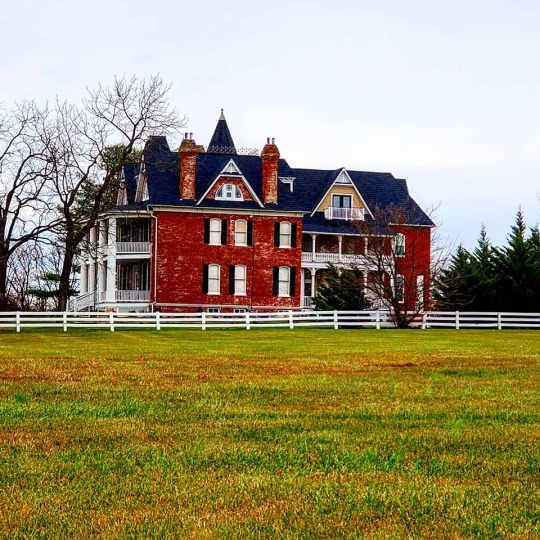
FB group/ Visit https://blog2collectionsanfavs.tumblr.com/ for more.
#house#home#large house#farmhouse#farm#land#mansion#porch#brick house#country living#beautiful#colorful#colonial home#victorian home
12 notes
·
View notes
Text
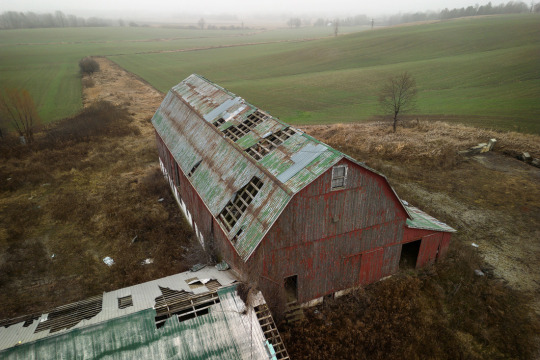

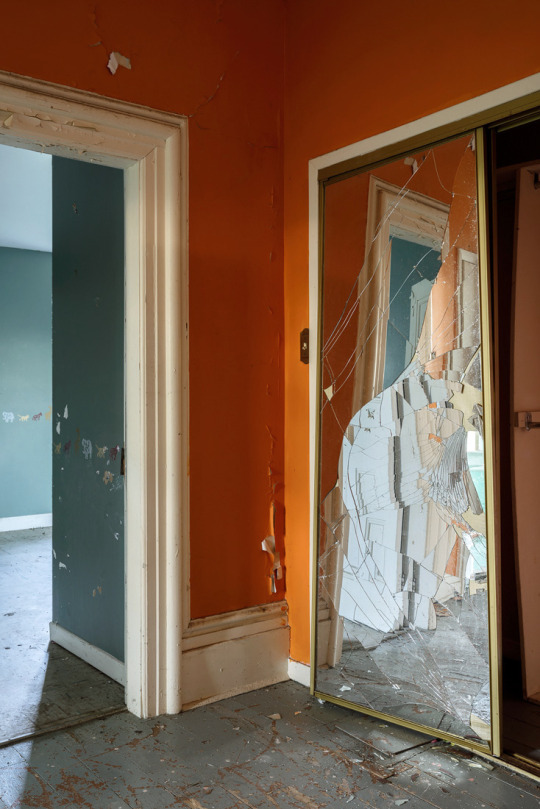

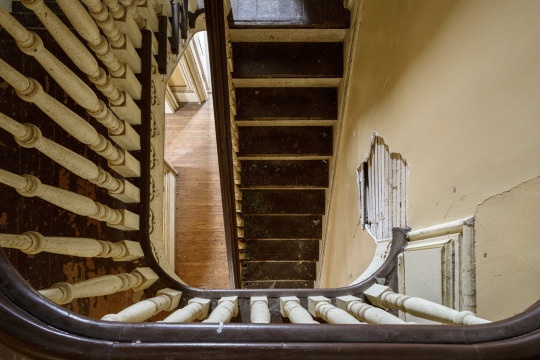
The Victorian
Check out the walkthrough, if you like!
Today let's have a look at a what the second storey looked like, along with the widow's walk!
Sitting on 112 acres, the original farm property dates back to the mid to late 19th century. While the Victorian house itself and original barn were built in the early 1900s.
The home had two towers, one on the front of the building and one on the west side of the house. During a time of neglect, the west side tower had began to pull away from the house and had to be removed. The owners at the time also removed all of the brick and added siding as a replacement.
In the early 1930s, the original barn burnt to the ground in a devastating fire. The owner at the time was later charged with arson. He thought that if the barn burned down, he could use the proceeds from the insurance claim to pay off the mortgage. A replacement barn was built years later and still sits on the property to this day.
Several years ago the property was sold to a development company and the buildings have sat abandoned and decaying ever since.
Unfortunately, the house is not protected under the heritage act and it will almost certainly be demolished in the future when the land is redeveloped.
#abandoned#urbex#urban exploring#urban exploration#bandos#abandoned buildings#abandoned places#forgotten#abandoned houses#forgotten buildings#abandoned homes#forgotten places#abandoned farmhouses#farmhouses#abandoned farm houses#videos#youtube
20 notes
·
View notes
Note
Is Elizabeth on your island, and if so how has she adjusted after decades abandoned?

She is! And here's my headcanon for her:
Topham Hatt I, (The Fat Director,) had by 1926 accumulated a small fortune as General Manager of the North Western Railway. Reputed as a workaholic, (or boss-aholic,) Topham had sunk considerable amounts of money into his sprawling Wellsworth estate, Topham Hall. Topham was inspired by the undertaking of his sometime friend Sir Robert Walker, the Baronet of Sand Hutton. Walker's estate utilized war surplus one foot and three inch gauge locomotives to carry distinguished guests, agricultural produce, and coal to and bricks deriving from the nearby brickworks of Claxton.
The resulting pet project, the Topham Hall Railway, is where Elizabeth's story begins.
The T.H.R. was laid to what had essentially become the Sudrian "standard narrow gauge," of two feet and three inches. The line started from its Exchange Siding with Wellsworth Station, and made several crossings through the streets of that town's suburbs, before reaching the estate grounds. Hall Station brought passengers within a stone's throw of the mansion itself. Moving on, the line dove into the woods through a magical tree tunnel, with a spur at its opening for the engine and carriage shed. Crossing a brook over a three-span wooden trestle bridge, another station and a few sidings known as "Orchard Station" served the fruit and vegetable orchard. Another mile or so, and the railway stopped again for "Bowler's Station," where the Hatts and any guests could detrain for the estate's cricket pavilion.
Another half a mile, and the railway terminated at the Wellsworth Brickworks. This had been a puny operation before the THR linked up with it, employing only three men or so. After the railway's arrival, it expanded to employ a few dozen, and three more kilns were added. Throughout the Great Depression, Topham kept the Brickworks open and its employees onboard out of his own pocket, even as the bricks accumulated unsold. This was far more humanitarian than his treatment of NWR employees and three of his engines!
The railway had one locomotive, a royal purple Kerr Stuart 'Tattoo' class, named "Little Barford," technically a brother of the Mid Sodor Railway's No. 4, "Stuart." Little Barford arrived also with several v-tipper wagons, a dozen ex-War Department bogie wagons, four-wheel trucks and two ambulance vans. The ambulance vans were thoroughly rebuilt by the estate's woodshop to become an elaborate passenger coach, and a "Dining Car," which was quite identical save for the fewer seats and teeny gas cooker. The passenger coach saw constant use, but the Dining Car mostly sat in the siding at Bowler's Station as it cooked. The line was so short, it never could've done more than boil an egg while moving to timetable!
Capping off this complement of rolling stock was one Sentinel DG4 "Overtype" Steam Lorry, quickly named Elizabeth, after the Duchess of York's newborn daughter. Elizabeth was absolutely coveted by Topham, though he wasn’t exactly a steady hand at the wheel. Elizabeth was kept polished to perfection, even when her work involved carting such grubby loads as soil, clay, and coal. She was in every respect a "father's princess," but she worked dutifully and loved Little Barford like a twin brother. She also learned from her Victorian old master her favorite catchphrase, "We are/are not amused!" depending on the context.
The Second World War began in September 1939, and this national shift in priorities turned Elizabeth’s devil-may-care youth on its head. The Wellsworth Brickworks shuttered as many of its men volunteered or were called up, and housing construction all but ended. Little Barford was kept on at the Hall as the Ministry of Agriculture and Fisheries set to increase production on Topham Hall’s farms. Elizabeth on the other hand was, for the first time, moved away from her only home. As the civilian petrol rationing situation tightened, and private motoring was eventually banned, Elizabeth was suddenly very valuable as a coal-fired road vehicle.
She was commandeered and relocated to Tidmouth Harbour, working night and day as a dockside lorry. This was a very stressful period for her, for she was utterly friendless and out of her element. Although Sodor was never bombed, the routine blackout drills and stories of other ports destroyed, such as Liverpool, took their toll on her mentally. At some point however, she "bucked up." Elizabeth realized she was no longer an aristocrat's toy. For all she knew, Topham had probably forgotten her. As the military lorries she came face to face with daily were almost all of the internal-combustion type, who was to say that when, if ever the war was over, that he'd want her back if he remembered her?
In these circumstances, Elizabeth adopted her more familiar, stiff-upper lip personality. There was no time for polish or quaint little rides to the cricket pavilion, there was a war on! She became grubby, and liked to be grubby. She worked like the devil, and loved that even more. Her posh accent never left her, but she was now in every respect out to be a working girl. Elizabeth would never admit it to herself, but this huge change of self owed much to her upset at being removed from her only home. Did she legitimately like being a working lorry, rather than an estate owner's princess? Certainly she did. Was it an easy and completely voluntary change of character? Of course not. But it was done, and Elizabeth spent many nights assuring herself that it was the right path, the only path to have taken.
1945, the end of the war. Everyone was so jubilant. Elizabeth was cleaned and polished like a crown jewel, decked out with flags and bunting, and allowed to participate in the Tidmouth Victory Parade. In several colour newswreels of the event, you can spot her amid the cascade of tickertape and throngs of soldiers, nurses, longshoremen, civilians, tanks and lorries. It was no doubt a fun day for her, but now she thought a great deal about the future.
The war, which had been everything to her for six years, was over. Soldiers were being demobilized and coming home. Industries were retooling for the postwar world, to make consumer goods rather than several airplanes an hour. The Attlee Government, in conjunction with the devolved Sudrian Parliament established in 1946, had a grand vision for The Mainland and Sodor, where the welfare state for the long-suffering people and machines was vastly expanded, their jobs would be increasingly unionized and their bosses answerable to them, rather than the other way around.
Despite the historically harsh winter into the New Year of 1947, Sudrian workers, bouncing back much quicker than their Mainland counterparts, were delighted with PM Attlee's "New Jerusalem." Tidmouth Harbour was still very busy, as Sodor's biggest gate in and out for the world, and Elizabeth kept calm and carried on as time marched on. She was much busier than she had first feared, and that winter was her time to shine as so many petrol lorries were out of commission with "head colds." Elizabeth convinced herself, somehow, that these thousands and thousands of war surplus petrol lorries wouldn't take over. If so many had taken ill in these conditions, maybe Sodor, or even the whole world, would consider turning back the clock and restoring steam to the roads completely.
She feared and resented petrol lorries something terrible. When the petrol ration which had enabled her life all this time, was finally ended, she was heartbroken. Every worry she had seemed to come to pass all at once. First, the Tidmouth Harbour Authority decided it would be much cheaper to stack its fleet with war surplus lorries, and she was out of a job. Her next owner, a furniture mover, didn't keep her long, and neither did the next, a man who planned to fit her out as a bus and ran out of money.
By 1956, when the now-knighted Sir Topham Hatt I had died, Elizabeth had already been accumulating dust in a shed for two years. She never saw her last owner, who by now had failed to pay rent on her storage. Anopha Quarry, who owned the tumbledown little shack, seized her to make up the difference, but never once came to inspect the lorry who was now their property. Eventually, the Quarry forgot about her too.
It wasn't until 1961, when a little blue puffer deputizing for Toby on the Quarry Tramway carelessly had a coupling rod failure, that she reemerged. She made a heartstopping journey down the line for the necessary spare rod, pins, oilpot and tools in Ffarquhar Sheds, where she stirred up quite a scene, before an even more uncomfortable journey back. Elizabeth's Sentinel heritage thankfully preserved her for the whole ordeal, when Thomas' Driver, then at her wheel, worried that she'd explode and take him with her.
Back into the shed she went after this good deed, for how long, if ever to come out again, she didn't know. Until of course, that same night, a man very like her old Master, named Bertram just like his son whom she had given so many rides through the orchards and to cricket games, came to make a visit...
You can guess the rest :3
Sir Bertram Topham Hatt I was reunited with his childhood friend, and his father's favorite lorry. He immediately sent for her with his own money to be restored, and at once moved her back to Topham Hall, where she was herself reunited with the closest thing to a brother she'd ever had, Little Barford, who this whole time had been working as well as ever, and wondered why no one had ever gone to look for Elizabeth despite all his questions. It had been assumed, wrongly, that Elizabeth had perished on war service. That's how the Tidmouth Harbour Authority wrote it, after they pocketed her sale money! (Sir Bertram was LIVID not to get his hands on the now deceased Harbourmaster responsible.)
Elizabeth is now back to her childhood home hauling farm produce and any visitor willing to get dirty, for she still insists on carrying a bit of grime as a testament to her labours. The Wellsworth Brickworks has reopened, on a much smaller scale, as a "living museum," and Elizabeth takes great joy in carrying clay and coal again. Her, Little Barford, and Sir Bertram are now tighter than they've ever been, and Sir Bertram is the only man allowed to polish her. He's a much more sedated force at the wheel than his father, she notes, and quite often!
We ARE amused to see her <3
#ttte#ttte elizabeth#ttte the fat director#topham hall railway#ttte little barford#ttte worldbuilding#ttte thomas#ttte oc: sir bertram hatt i#tw death
23 notes
·
View notes
Text
Cincinnati Trembled At The Loathsome Horrors Of The City Pest-House
Throughout the 1800s perhaps the most terrifying phrase uttered in Cincinnati was “pest house.” In those days of primitive, pre-antibiotic medicine, consignment to the pest house was essentially a death sentence. Sick people transferred to the pest house suffered from contagious and incurable diseases including smallpox, yellow fever and even the plague.
Cincinnati’s first pest house was located in the West End, just a stone’s throw from the Commercial Hospital on the west side of the canal. As that part of the city filled up with housing, a NIMBY (Not In My Back Yard) movement arose, forcing administrators to locate a new “branch” hospital on the hillside slope near Clifton Avenue. The Cincinnati Commercial Tribune [6 February 1864] rejoiced:
“The great inconvenience of having to use a small building in the rear of the Commercial Hospital, corner of Fourteenth street and Central avenue, has, for a long time, been experienced, and we are glad to see that the nuisance is in a fair way of being abated. A large building on Ross [Roh’s] Hill has been fitted up, at a cost of about $1,000, and lately put in use as a pest house, there being now twenty-seven cases of small-pox there. The old pest house also contains the same number of cases.”
The Roh’s Hill pest house occupied a plot of land occupied today by the northern half of Rohs and Chickasaw streets. The property included a main building of brick, three frame houses, a wash house and a stable at the time it was acquired by the hospital. There was also, on the southern part of the property, a vineyard, which the hospital leased to a local winery who seemed unconcerned about the adjacent contagion.

In addition to smallpox, the pest house soon filled with patients suffering measles, scabies, cholera, malaria, typhus, influenza and tuberculosis. Even though the Roh’s Hill branch hospital was located on a five-acre tract of land in a lightly inhabited section of the city, neighbors complained about the proximity of patients suffering loathsome diseases. Responding to complaints, City Council authorized its Committee on Health to find an even more isolated site for the pest house. According to the daily Gazette [29 October 1869] that search produced nothing but outrage:
“But while they find plenty of owners that are ready to sell land for the purpose, they find that the people of the vicinity do not desire this institution located among them. Indeed, whenever they go even to view a tract, they carry a panic, and the neighborhood rise up and charge them with all sorts of conspiracies, and threaten to burn down their concern if they bring it among them.”
That anxiety can only have been exacerbated when Sergeant Benjamin Hook of the Corryville station house made a grisly discovery. Passing the pest house, Sergeant Hook noticed a bright object protruding from a pile of ashes. According to the Enquirer [25 July 1872]:
“Sticking his cane into the heap he soon pushed enough of it away to show that the object that had attracted his attention was the coffin of an infant child. Upon drawing it out he also found that it contained the form of a female child about six months old, beautifully dressed, that had apparently been dead only a day or two.”
At the coroner’s inquest, it came out that the infant had been buried, forgotten, in the ash pile since February. The Roh’s Hill pest house regularly stashed corpses in the ash pile while waiting for the ground to thaw sufficiently for burial, or for enough bodies to accumulate to constitute a decent-sized wagon load for the trip to the Potter’s Field graveyard in Price Hill. The Enquirer [26 July 1872] expressed the intensity of the community’s horror.
“Aside from the inhumanity of the thing, it was sufficient to imperil the health of the community. Persons walking or driving past the premises were at any time liable to inhale the noxious vapors arising from these corpses and to be inoculated with the terrible scourge.”
During the decade that the Roh’s Hill pest house was in operation, Cincinnati’s population surged by 20 percent and many affluent residents sought cleaner air and spacious lawns in the hillside districts. The branch hospital was a blight on an increasingly attractive (and lucrative) neighborhood. Although homeowners were frightened away, real estate speculators smelled opportunity. The Enquirer [17 May 1879] was incensed:
“The proposed removal of the Pest-house from Roh’s Hill is a job designed to benefit a few crafty property-holders, who urge it for their own personal gain, and not with an eye single for the public good. These parties purchased ground on the hill and in its vicinity at extremely low prices on account of the proximity of the Pest-house, and now that they may benefit themselves they propose to remove the institution to the western hills, where its presence will greatly depreciate property extremely valuable to the owners.”
The speculators fired up the neighbors who prevailed upon City Council and the Commercial Hospital board to condemn the Roh’s Hill pest house. The hospital at first tried to sell the buildings for scrap, but public belief that bricks and lumber from the hospital harbored contagious diseases quashed that idea. On 27 June 1879, the Rose Hill pest house was put to the torch.
Two weeks before burning the pestiferous institution, the trustees of the City Hospital filed a plat creating the Roh’s Hill subdivision. According to that plat, now on file at the Hamilton County Recorder’s office, one of the “crafty property-holders” angling for the removal of the pest house was Jacob Elsas, secretary of the hospital board. In a case of Victorian insider trading, Elsas swept in to purchase the southern third of the pest house property.
The old Roh’s Hill pest house still had secrets to divulge. A year after the structure was burned to the ground, in May 1880, the bleached bones of an unknown man were found in a gully south of the pest house site. A crew from the morgue, sent to investigate, presumed that the bones were those of a long-dead smallpox victim. According to the Daily Gazette [13 May 1880]:
“Coroner [Anthony Lawless] Carrick, upon learning the nature of the find, ordered [Undertaker John B.] Habig to bury the bones, and deemed an inquest unnecessary unless some unexplained murder a dozen years ago should be brought to light.”
With Roh’s Hill demolished, the city needed a new pest house for its contagious and incurable patients, and found it in the 50-acre Gurley farm located between Price Hill and Westwood. As “pest house” had become a disagreeable term, the new quarantine hospital was named the Hamilton County Tuberculosis Sanatorium and, later, Dunham Hospital. It is now Dunham Recreation Center.
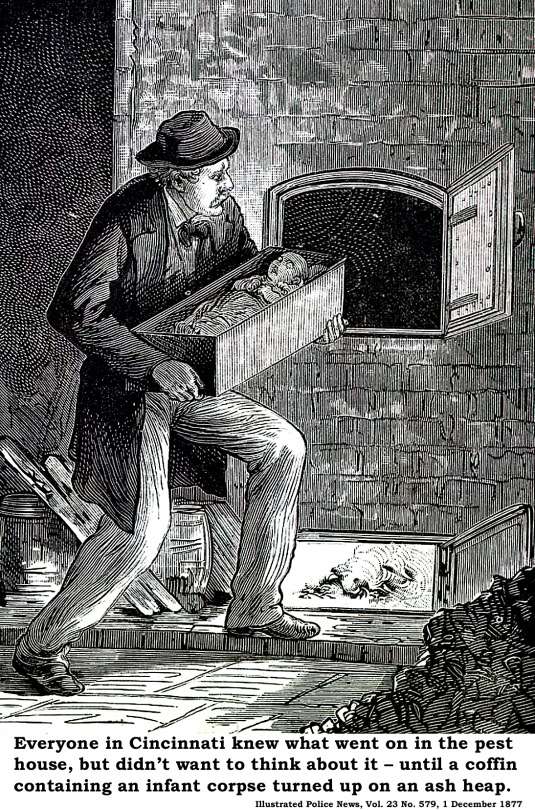
#dunham hospital#dunham recreation center#pest house#cincinnati pest house#roh's hill#isolation hospital
15 notes
·
View notes
Note
i think you might need psychiatric support
Oh, that's so cute! Thank you so much for your concern for my well-being and the well-being of others, mein wachsames Raubtier!
I was brought to an ER once. I literally had no idea what was going on and really didn't care. I won't pretend to tell anyone what they should do, but if you find yourself in these sort of situations saying nothing and just cooperating reduces your headaches later. I guess if you were taking someone, telling them as little as possible to get them moving probably is for the better. Just "we need to take a drive."
Anyway, they took away my clothes and I got examined which was humiliating because they took away my clothes and could see all the carving I'd been doing, but also kind of exciting because they took away my clothes and could see all the carving I'd been doing. I've said before, Liebchen, that I am probably not sapient, and this carving was no different than anything else. Automatic actions that just occur and have to be interpreted later to imagine a character for this machine that carves away cutting itself into the world. Have you ever seen the patterns made by ants in an ant farm? I think I had a bit of an awakening there on that table. And then I had to do those stupid cognitive tests which are stupid. Giraffes and clocks and stuff.
And then in-patient. Absolutely terrible time. Group sessions with sad broken animals who'd been there for so long they'd become enamored with earning their Princess Points and getting privileges like walking outside. There was a woman with a sort of interesting story that isn't mine to tell. Watching people shuffle around, play ping-pong against a wall, everyone wears slippers, privacy curtain in front of the bathroom, etc. Before being brought there, I'd become in the habit of jogging for hours along the beach while I dissociated, so my resting heart rate was about 30 BPM. Of course this can also be a ~uwu~symptom~uwu~ of some things, so a nurse checked my heart rate every four hours, including waking me up twice in the night. The hospital also didn't like that I only ate once or twice a day, but I was used to traveling 25-35 miles a day (depending on what work had entailed), and deprived of that I simply didn't need calories. Went cat mode, you know, Katzchen? Sit as still as possible and enjoy the few hours of sunlight I could get through my room's window.
Anyway, here's the funny part, the punch line, the ward had a "library," a couple bookshelves with donated books. During my first day I skimmed through it and found Night in Tunisia an anthology by Neil Jordan. It struck my attention due to a connection to the country and Libya that I'm not going to disclose. Anyway, I picked it up and read it and the first story was "Last Rites." I read the whole book through, but "Last Rites" was the one that obsessed me and I reread it over and over again during my time, until certain portions were etched into my brain:
He knew he anticipated something approaching the baths. He knew that it wasn't quite pleasure. It was something more and less than pleasure, a feeling of ravishing, private vindication, of exposure, of secret, solipsistic victory. Over what he never asked, but he knew as he approached the baths to wash off the dust of this week's labor that this hour would be the week's high-point. Although during the week he never thought of it, never dwelt on its pleasures when the hour came it was as if the secret thread behind his week's existence was emerging into daylight, was exposing itself to the scrutiny of daylight, his daylight.
They saw the body and didn't hear the finer details--just heard that it had been born, had grown, and suffered much pain and a little joy. That its dissatisfaction had been deep, and they thought of the green bridge and the red-brick walls and understood.
Because the exhaustion was delicious now and bleak, and because he knew there could never by anything but exhaustion after all that fury, all the expanse of passion and shame, he walked through the green-rose curtain and he took the cut-throat razor from his pack and went back to the shower and cut his wrists. And dying, he thought of nothing more significant than the way he had come here, of the green bridge and the bowed figure under the brick wall and the facade of the Victorian bath-house, thought: there is nothing more significant.
Now, thinking of the story is one of those things that can make me cry, but back then I was just filled with delight at the irony of it all. Here in the heart of the Medical-Industrial complex is the key to it all. The escape. It was then that I started to understand Mother Death, her infinite mercy and sweetness. Anyway, eventually they let me loose when they decided I wasn’t a danger to anyone and also wasn’t being helped. I did outpatient for awhile, but none of it ever helped and I ghosted as soon as I could. I’ve got a laundry list of diagnoses I can choose from, but Schizoaffective suits me best.
Anyway, Honigbienchen, the talking cure isn’t for everyone. In fact, I have never benefited from talking to anyone and it has always resulted in complications and pain. Better to pretend I’m one of those deaf-mutes and wait for everyone to leave me as they must, ya know? Mother Death and the Hoofprints of the Goddess are all I really need, that and the strength and wisdom to follow them, and I have to find that on my own.
Just as you too, mein blutrot Stern, must trace your own path across my sky.
7 notes
·
View notes